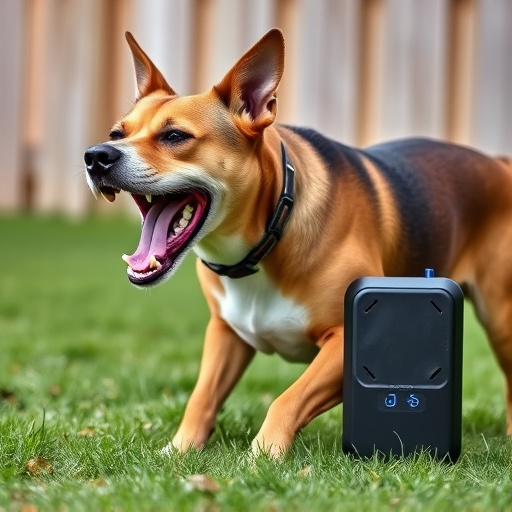Ultrasonic repellents are humane, effective tools for addressing dog behaviors like excessive barking or encroachment using high-frequency sound waves audible only to dogs. The Ultrasonic Repellent Range designed for large dogs covers broader areas with powerful devices that operate outdoors and are portable, easy to use, and feature adjustable settings. Their effectiveness depends on range (50-150 feet), influenced by environmental factors; multiple units may be needed for larger breeds in expansive yards. Training requires patience and consistency, using positive reinforcement while maintaining safe operation at a distance from dogs' heads.
“Discover the power of ultrasonic technology in managing canine behavior with our comprehensive guide. We explore the effectiveness of ultrasonic repellents, specifically focusing on handheld devices designed for large dog owners. Learn how these innovative tools emit high-frequency sound waves to deter barking without harm. From understanding the science behind ultrasonic repelents to mastering training techniques, this article covers everything you need to know to choose and use a handheld unit effectively within the optimal ultrasonic repellent range for large dogs.”
- Understanding Ultrasonic Repellents for Dogs
- Features and Benefits of Handheld Units
- Effective Range and Dog Size Considerations
- Training and Safety Tips for Using Ultrasonic Devices
Understanding Ultrasonic Repellents for Dogs
Ultrasonic repellents are a humane and effective way to deter dogs from unwanted behavior, such as barking excessively or wandering into certain areas. These devices emit high-frequency sound waves that are inaudible to humans but can be irritating to dogs, encouraging them to stay away. The ultrasonic repellent range for large dogs is typically designed to cover larger spaces, addressing the unique needs of bigger breeds that may have a stronger impact on their environment.
These handheld units allow users to direct the sound wave emission precisely where it’s needed most, without causing harm or stress to the animal. They are easy to operate and can be carried conveniently for immediate use when required. The effectiveness of an ultrasonic repellent lies in its ability to condition a dog’s behavior through consistent and targeted application, making it a popular choice among pet owners looking for a safe and reliable solution.
Features and Benefits of Handheld Units
Handheld ultrasonic bark control units offer a convenient and effective solution for managing excessive barking, especially in larger dog breeds. One of their key features is the powerful yet safe ultrasonic repellent range, designed to cover a significant area, making them ideal for outdoor use and managing dogs over a wide space. This technology emits high-frequency sound waves that are inaudible to humans but irritant to dogs, quickly distracting them from barking spasms.
These devices are lightweight and portable, allowing users to easily navigate and target specific areas where barking is an issue. Their compact size also makes them user-friendly, enabling quick deployment and adjustment without the need for extensive setup. Additionally, many handheld units come with adjustable settings, allowing for customization based on different dog behaviors and environments, ensuring a more tailored approach to bark control.
Effective Range and Dog Size Considerations
The effectiveness of an ultrasonic bark control device is heavily influenced by its range. These devices typically operate within a 50-150 foot (15-45 meter) radius, depending on the model and environmental factors like wind and interference. When considering an ultrasonic repellent for large dogs, it’s crucial to assess this range in relation to your yard size and where the dog spends most of its time. For extensive areas or active dogs that roam beyond the stated range, multiple units might be necessary to ensure continuous coverage.
The size of the dog is another factor to keep in mind. While ultrasonic repellents are designed to deter barking by emitting high-frequency sound waves, smaller dogs may not be as sensitive to these frequencies as larger breeds. For effective bark control with large dogs, choosing a device with a longer range and higher decibel output can be more beneficial. This ensures the dog receives consistent signals even when they venture slightly beyond the nominal range of the unit.
Training and Safety Tips for Using Ultrasonic Devices
Training your dog to respond to an ultrasonic bark control unit requires patience and consistency. Start by introducing the device in a low-stress environment, allowing your dog to get used to its sound. Gradually increase the sensitivity level as they learn to associate the tone with their barking. Positive reinforcement is key; reward quiet behavior with treats or praise. Begin training sessions at a calm moment to avoid frustrating both you and your pet.
Safety is paramount when using any ultrasonic device. Always hold the unit away from your dog’s head, aiming for a distance of 15-30 cm (6-12 inches). Never point it directly at their eyes or ears as the high-frequency sound can be uncomfortable for these areas. Ensure good ventilation during use, and keep the device out of reach of children and other pets to prevent accidental activation. For large dogs with a long ultrasonic repellent range, maintain a safe distance when operating the unit, allowing them to hear the tone but not directly targeting them.
The ultrasonic handheld unit offers a humane and effective solution for managing dog barking, particularly in addressing the specific challenge of controlling large dogs. By understanding the principles of ultrasonic repelents and implementing training tips, owners can harness this technology’s range—up to 30 feet—to create a peaceful environment without resorting to harsh methods. Remember, consistent use and combining it with positive reinforcement are key to success. With proper application, this device can be a game-changer for managing barking in various scenarios, ensuring a quieter and more harmonious home.
